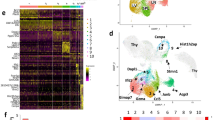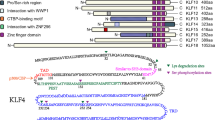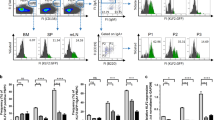Abstract
Mammalian Kruppel-like transcription factors are implicated in regulating terminal differentiation of several tissue types1,2,3. Deficiency in Kruppel-like factor (KLF) 2 (also known as LKLF) leads to a massive loss of the peripheral T-cell pool4, suggesting KLF2 regulates T-cell quiescence and survival4,5,6,7. Here we show, however, that KLF2 is essential for T-cell trafficking. KLF2-deficient (Klf2-/-) thymocytes show impaired expression of several receptors required for thymocyte emigration and peripheral trafficking, including the sphingosine-1-phosphate (S1P) receptor S1P1, CD62L and β7 integrin. Furthermore, KLF2 both binds and transactivates the promoter for S1P1—a receptor that is critical for thymocyte egress and recirculation through peripheral lymphoid organs. Our findings suggest that KLF2 serves to license mature T cells for trafficking from the thymus and recirculation through secondary lymphoid tissues.
This is a preview of subscription content, access via your institution
Access options
Subscribe to this journal
Receive 51 print issues and online access
$199.00 per year
only $3.90 per issue
Buy this article
- Purchase on SpringerLink
- Instant access to full article PDF
Prices may be subject to local taxes which are calculated during checkout




Similar content being viewed by others
References
Dang, D. T., Pevsner, J. & Yang, V. W. The biology of the mammalian Kruppel-like family of transcription factors. Int. J. Biochem. Cell Biol. 32, 1103–1121 (2000)
Kaczynski, J., Cook, T. & Urrutia, R. Sp1- and Kruppel-like transcription factors. Genome Biol. 4, 206 (2003)
Turner, J. & Crossley, M. Mammalian Kruppel-like transcription factors: more than just a pretty finger. Trends Biochem. Sci. 24, 236–240 (1999)
Kuo, C. T., Veselits, M. L. & Leiden, J. M. LKLF: a transcriptional regulator of single-positive T cell quiescence and survival. Science 277, 1986–1990 (1997)
Kuo, C. T. & Leiden, J. M. Transcriptional regulation of T lymphocyte development and function. Annu. Rev. Immunol. 17, 149–187 (1999)
Buckley, A. F., Kuo, C. T. & Leiden, J. M. Transcription factor LKLF is sufficient to program T cell quiescence via a c-Myc-dependent pathway. Nature Immunol. 2, 698–704 (2001)
Di Santo, J. P. Lung Kruppel-like factor: a quintessential player in T cell quiescence. Nature Immunol. 2, 667–668 (2001)
Anderson, K. P., Kern, C. B., Crable, S. C. & Lingrel, J. B. Isolation of a gene encoding a functional zinc finger protein homologous to erythroid Kruppel-like factor: identification of a new multigene family. Mol. Cell. Biol. 15, 5957–5965 (1995)
Wani, M. A., Means, R. T. Jr & Lingrel, J. B. Loss of LKLF function results in embryonic lethality in mice. Transgenic Res. 7, 229–238 (1998)
Wani, M. A., Wert, S. E. & Lingrel, J. B. Lung Kruppel-like factor, a zinc finger transcription factor, is essential for normal lung development. J. Biol. Chem. 274, 21180–21185 (1999)
Kuo, C. T. et al. The LKLF transcription factor is required for normal tunica media formation and blood vessel stabilization during murine embryogenesis. Genes Dev. 11, 2996–3006 (1997)
Schober, S. L. et al. Expression of the transcription factor lung Kruppel-like factor is regulated by cytokines and correlates with survival of memory T cells in vitro and in vivo. J. Immunol. 163, 3662–3667 (1999)
Grayson, J. M., Murali-Krishna, K., Altman, J. D. & Ahmed, R. Gene expression in antigen-specific CD8+ T cells during viral infection. J. Immunol. 166, 795–799 (2001)
Wu, J. & Lingrel, J. B. Kruppel-like factor 2, a novel immediate-early transcriptional factor, regulates IL-2 expression in T lymphocyte activation. J. Immunol. 175, 3060–3066 (2005)
Wu, J. & Lingrel, J. B. KLF2 inhibits Jurkat T leukemia cell growth via upregulation of cyclin-dependent kinase inhibitor p21WAF1/CIP1. Oncogene 23, 8088–8096 (2004)
Haaland, R. E., Yu, W. & Rice, A. P. Identification of LKLF-regulated genes in quiescent CD4+ T lymphocytes. Mol. Immunol. 42, 627–641 (2005)
Mick, V. E., Starr, T. K., McCaughtry, T. M., McNeil, L. K. & Hogquist, K. A. The regulated expression of a diverse set of genes during thymocyte positive selection in vivo. J. Immunol. 173, 5434–5444 (2004)
Gabor, M. J., Godfrey, D. I. & Scollay, R. Recent thymic emigrants are distinct from most medullary thymocytes. Eur. J. Immunol. 27, 2010–2015 (1997)
Feng, C. et al. A potential role for CD69 in thymocyte emigration. Int. Immunol. 14, 535–544 (2002)
Boursalian, T. E., Golob, J., Soper, D. M., Cooper, C. J. & Fink, P. J. Continued maturation of thymic emigrants in the periphery. Nature Immunol. 5, 418–425 (2004)
Arbones, M. L. et al. Lymphocyte homing and leukocyte rolling and migration are impaired in L-selectin-deficient mice. Immunity 1, 247–260 (1994)
Wagner, N. et al. Critical role for β7 integrins in formation of the gut-associated lymphoid tissue. Nature 382, 366–370 (1996)
Wagner, N. et al. L-selectin and β7 integrin synergistically mediate lymphocyte migration to mesenteric lymph nodes. Eur. J. Immunol. 28, 3832–3839 (1998)
Cyster, J. G. Chemokines, sphingosine-1-phosphate, and cell migration in secondary lymphoid organs. Annu. Rev. Immunol. 23, 127–159 (2004)
Nakayama, T. et al. The generation of mature, single-positive thymocytes in vivo is dysregulated by CD69 blockade or overexpression. J. Immunol. 168, 87–94 (2002)
Shiow, L. R. et al. CD69 acts downstream of interferon-α/β to inhibit S1P1 and lymphocyte egress from lymphoid organs. Nature 440, 540–544 (2006)
Matloubian, M. et al. Lymphocyte egress from thymus and peripheral lymphoid organs is dependent on S1P receptor 1. Nature 427, 355–360 (2004)
Allende, M. L., Dreier, J. L., Mandala, S. & Proia, R. L. Expression of the sphingosine-1-phosphate receptor, S1P1, on T-cells controls thymic emigration. J. Biol. Chem. 279, 15396–15401 (2004)
Lo, C. G., Xu, Y., Proia, R. L. & Cyster, J. G. Cyclical modulation of sphingosine-1-phosphate receptor 1 surface expression during lymphocyte recirculation and relationship to lymphoid organ transit. J. Exp. Med. 201, 291–301 (2005)
Liu, Y. et al. Edg-1, the G protein-coupled receptor for sphingosine-1-phosphate, is essential for vascular maturation. J. Clin. Invest. 106, 951–961 (2000)
Acknowledgements
We thank J. Cyster for generous provision of CCL19–Fc fusion protein, Y. Li for developing S1P1 RT–PCR assays, M. Jenkins and M. Mescher for critical input on the manuscript, and members of the ‘Jamequist’ laboratory for helpful discussions. This work was supported by the NIH (an immunology pre-doctoral training grant to B.T.E., a grant to K.A.H., and a grant to S.C.J.), the American Cancer Society (a grant to S.C.J.), and the Cancer Research Institute (post-doctoral fellowship to C.M.C.).
Author information
Authors and Affiliations
Corresponding authors
Ethics declarations
Competing interests
Reprints and permissions information is available at npg.nature.com/reprintsandpermissions. The authors declare no competing financial interests.
Supplementary information
Supplementary Notes
This file contains Supplementary Methods with eight references, details of grant support and Supplementary Figures S1–S4 with legends. Supplementary Figure S1 details the normal in vitro survival of KLF2-/- mature thymocytes. Supplementary Figure S2 shows aberrant trafficking and phenotype of KLF2-/- SP thymocytes after adoptive transfer. Supplementary Figure S3 details real-time PCR analysis of gene expression in KLF2-/- and KLF2+/- DP and CD4 SP thymocytes. Supplementary Figure S4 shows the sequence of human and mouse S1P1 promoters, showing the CACCC sequence and the location of primers used for the CHiP assay. (PDF 453 kb)
Rights and permissions
About this article
Cite this article
Carlson, C., Endrizzi, B., Wu, J. et al. Kruppel-like factor 2 regulates thymocyte and T-cell migration. Nature 442, 299–302 (2006). https://doi.org/10.1038/nature04882
Received:
Accepted:
Issue date:
DOI: https://doi.org/10.1038/nature04882
This article is cited by
-
FOXP1 and KLF2 reciprocally regulate checkpoints of stem-like to effector transition in CAR T cells
Nature Immunology (2024)
-
A genome-wide in vivo CRISPR screen identifies essential regulators of T cell migration to the CNS in a multiple sclerosis model
Nature Neuroscience (2023)
-
How autoreactive thymocytes differentiate into regulatory versus effector CD4+ T cells after avoiding clonal deletion
Nature Immunology (2023)
-
Tissue-resident immune cells in the pathogenesis of multiple sclerosis
Inflammation Research (2023)
-
Krüppel-like factor 2 controls IgA plasma cell compartmentalization and IgA responses
Mucosal Immunology (2022)



